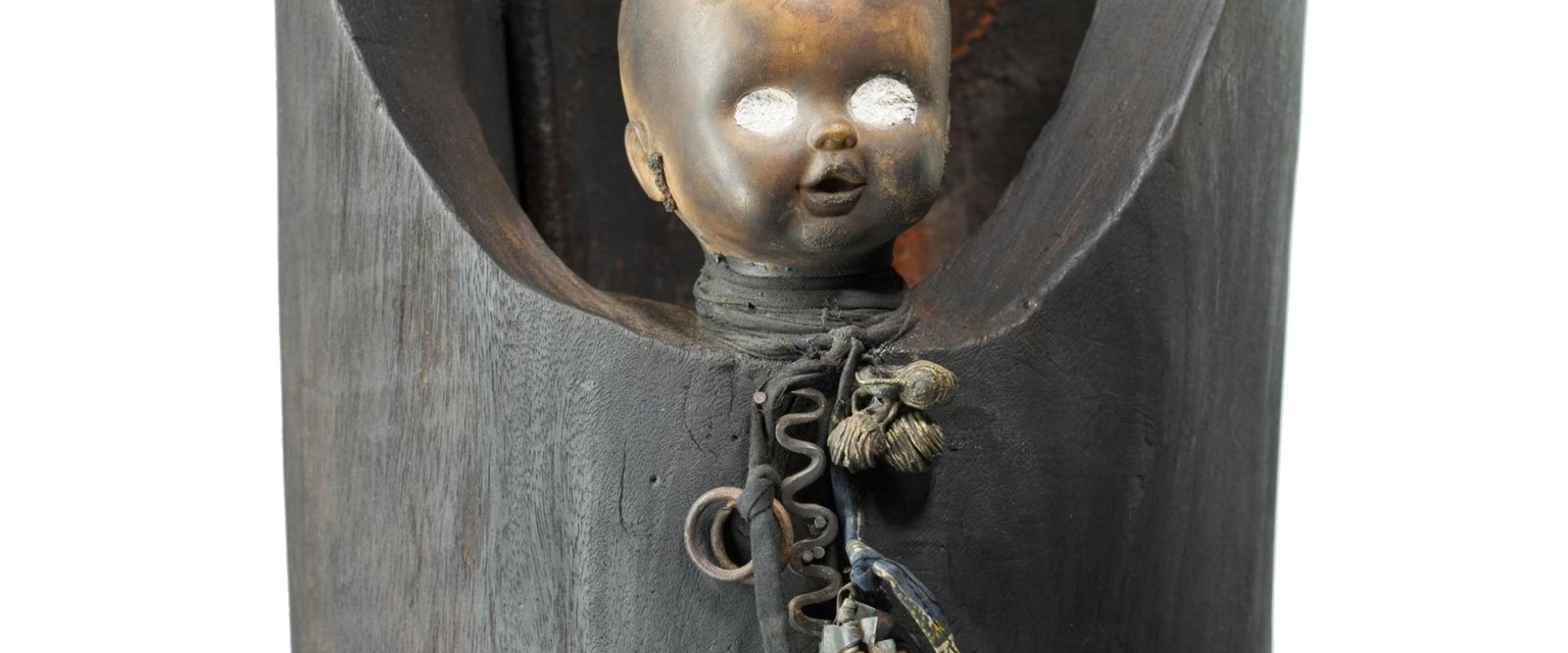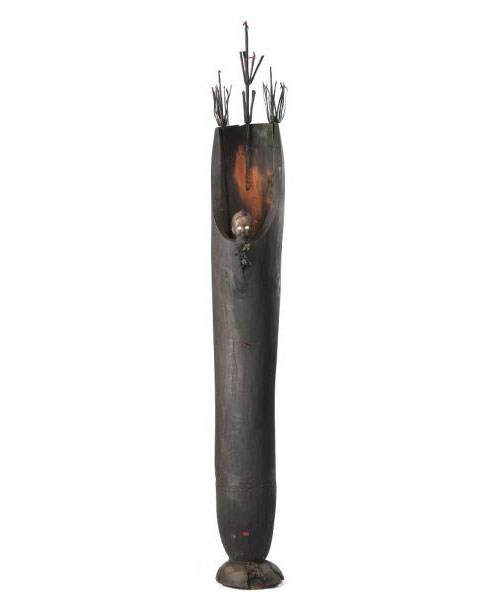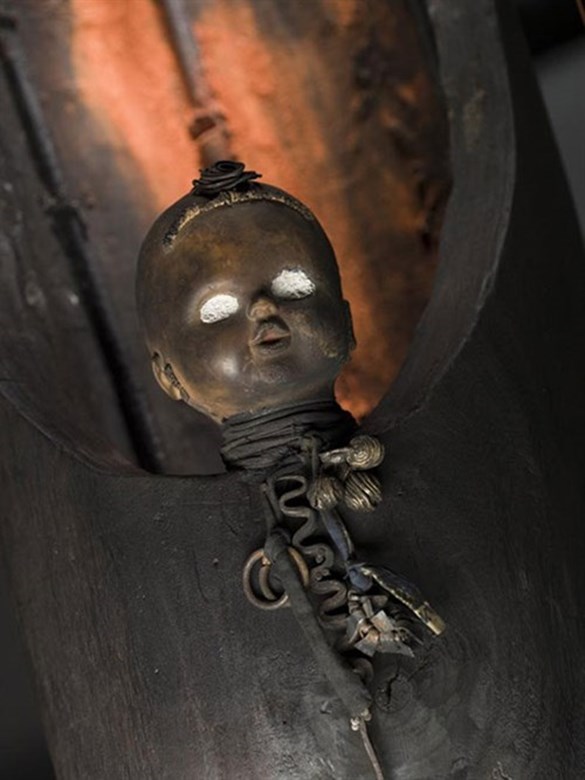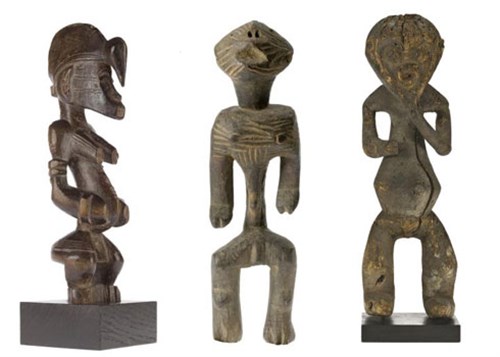Key in a search term below to search our website.
Key in a search term below to search our website.

This bold and engaging sculpture is a mixed media piece made from recycled found objects. It was created in 2008 by Gérard Quenum, an artist from the Republic of Benin, and can be seen in the Artistic Legacies gallery.
Date
2008
Made in
Porto Novo, Republic of Benin, West Africa
Made by
Gérard Quenum (b.1971)
Made from
Wood, metal, clay, iron, plastic, brass and cotton
Acquired
Purchased from the October gallery
Museum reference
On display
Artistic Legacies, Level 5, National Museum of Scotland
Did you know?
You can find sculptures by Gérard Quenum in galleries across the world, including the British Museum, the Pigozzzi Collection in Switzerland, the Museum Afro-Brasil in Sao Paulo, Brazil, the Galeria Bernado Marques in Lisbon, Portugal and in the collection of the Government of Benin.
Gérard Quenum is an African artist from the Fon ethnic and linguistic group in the Republic of Benin and one of the new generation of francophone artists emerging onto the international stage. Born in 1971 in the coastal town of Porto Novo, the official capital of the Republic of Benin, Quenum is one of a tightly-knit group of rising artists in Porto Novo and Cotonou, brought together by Dominique Zinkpé. With few art galleries in Benin, they arranged spontaneous exhibitions of their work outside on the city streets, known as Boulev’art (Art on the Boulevard).
Gérard Quenum follows in the footsteps of contemporary artists from Benin who have been attracting the attention of western collectors since the 1980s. But unlike a number of internationally successful African artists, he has not trained in a European institution in the western tradition but has developed his own original and provocative artistic style within a creative local environment.

Quenum’s work consists of compositions of found objects, whose diverse histories contribute to the overall significance of the sculptures themselves. Many of Quenum’s sculptural forms reference the guardian figure known as the bocia. Carved wooden bocia figures are decorated with various added materials, and prescribed by Fon priests and diviners to promote health and wellbeing. Through the combination of materials he uses, Quenum directly references established traditions and practices, both social and spiritual.
Quenum’s art is given a unique twist through the use of discarded dolls, which he adds to the mix of objets trouvés to create witty ‘portraits’ referencing real and imagined individuals. The dolls have their origins in the European aid packages sent to African children. They are collected by Quenum after they have been played with and finally discarded by the local street children. Already involved in what Quenum thinks of as a naturalisation process, the dolls undergo further transformation or ‘Africanisation’ by Quenum. Using a blow torch he blackens the white skin and singes the blonde hair to approximate ‘Afro’ hairstyles. Their addition to the found elements, which include wood reclaimed from old house frames and boat building, metal, shells, textiles and pottery, gives Quenum’s sculptures their distinctive dynamism and energy.

Above: Close up of the doll at the heart of L’Ange.
Quenum explains the creation of ‘L’Ange’ as follows:
"I work always from recyclable materials. The dolls that I use are old dolls. They served to generations of children who expressed through them their personal history and the family in which they grew up … The wood also has a story… used, sometimes for over a century, for houses in the swampy area of Porto Novo. They also witnessed the lives of many generations of families.
"For the sculpture called the Angel, in addition to wood and the doll, I purchased three Assin. These are metal ritual objects that represent the soul of the living dead. Angel covers the neck with small brass bells, which are the product of a very successful craft. They express patience and work of men. The Angel is responsible for the souls of ancestors and the prayers of men, he is the mediator between earth and sky.
"Small pieces of red cloth on the sculpture express the vital energy, blood. The Angel is also a principle of life. Like most of my works, the force of life here depends on the ability to keep alive the memory of the past and the dead.
"After three months of work and reflection on this piece, I realized that I failed to finish. Still missing something. So I left it in a corner of my studio and I tried to forget. Some time later, when I passed, to my great surprise, the head of the Angel, the empty orbits so far, had miraculously found eyes. I approached the sculpture, at which time a wasp landed on it. I understood then what had happened: the wasp had taken up residence in the head of the angel, and had begun to fill the eyes with a white substance, probably kaolin from the ground at the edge of the lagoon in front of me. The sculpture seemed so perfect. The wasp had completed the work that I started."
L’Ange was purchased in 2009 for display in the Artistic Legacies gallery. It was selected as a contemporary response to the display case of traditional African carved wooden figurative sculpture selected from our collections. With the inclusion of this 21st century interpretation of figurative sculpture, the visitor is presented with a dynamic, rather than static experience of African art. In this sculpture we see the powerful expression of Quenum’s creative ideology, which incorporates many elements from artistic traditions of the past reinterpreted in a thought provoking and compelling form.

Above: Carved wooden figures from Africa on display in the Artistic Legacies gallery.
In 2012, the delicate eyes of the sculpture were damaged, posing an interesting and unique challenge for our conservation team. This blog post by Artefact Conservator Diana de Bellaigue explains how she solved the problem.
L’Ange is now back on display in the Artistic Legacies gallery, protected by a new case.